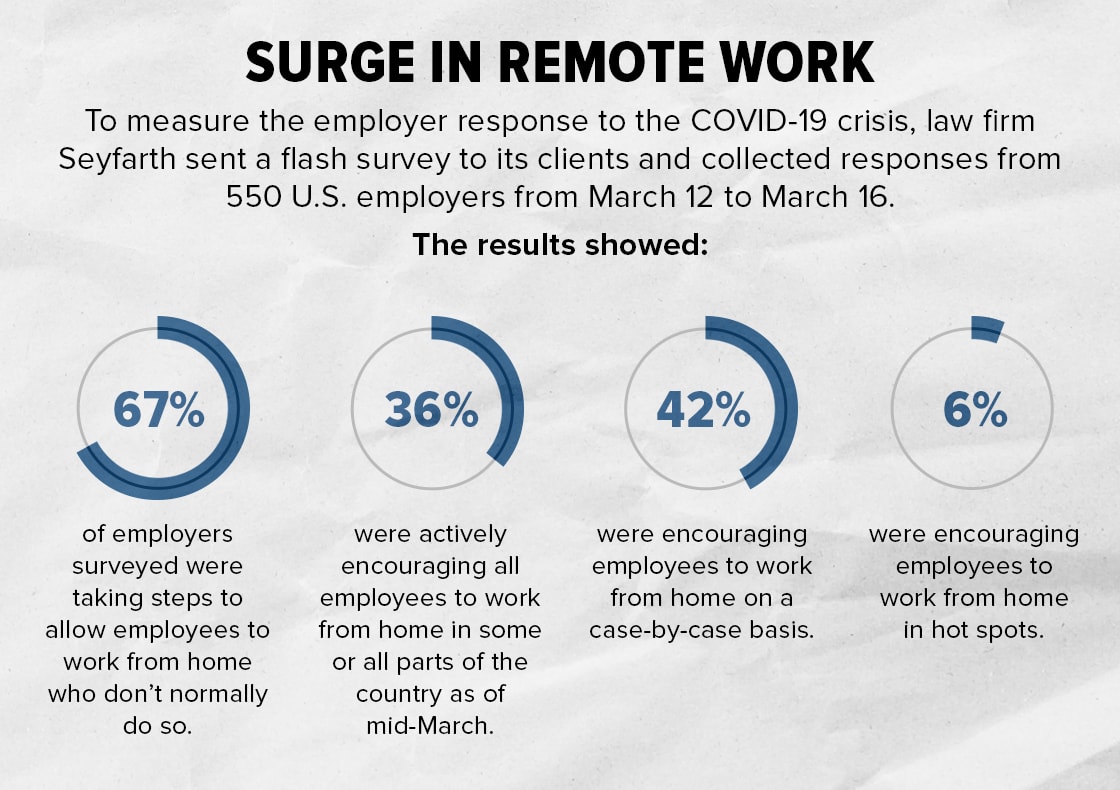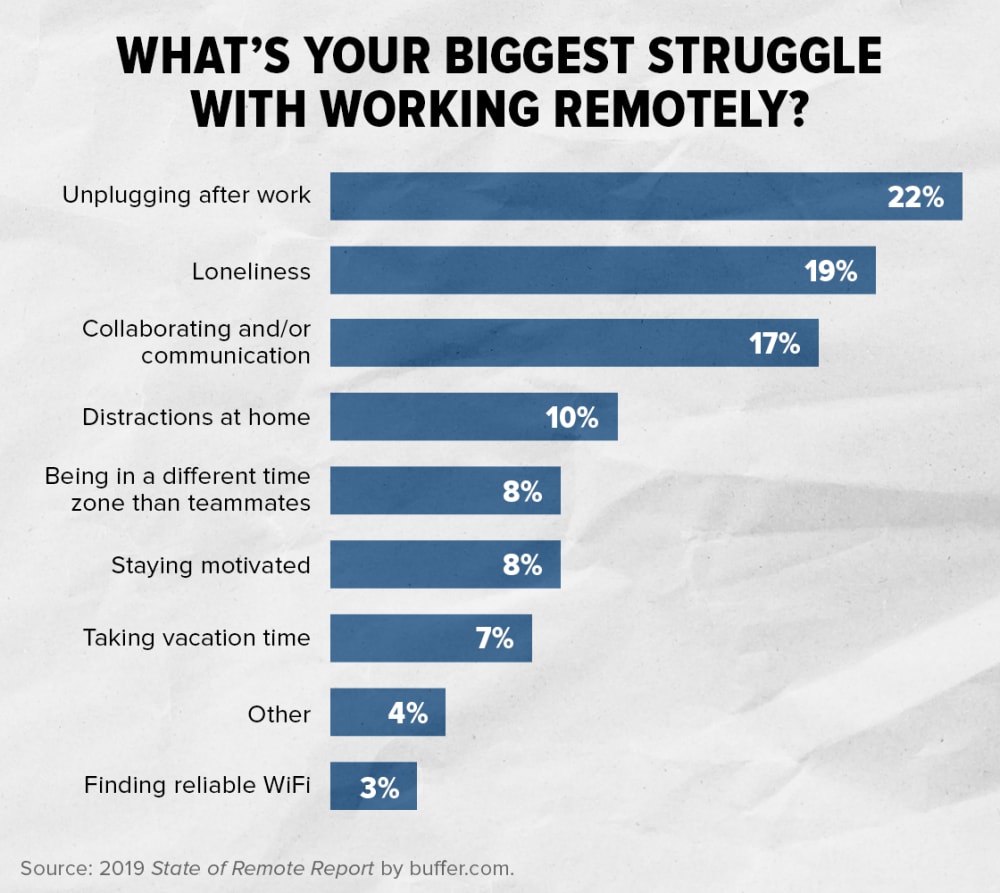Coronavirus Makes Work from Home the New Normal
Employers and workers adapt to new ways of getting work done.
When two new hires showed up for their first day on the job at New York City commercial real estate company SquareFoot in early March, their orientation was anything but normal.
At any other time, the open-space office would have been bustling with activity and the company’s 70-some employees would have given the newbies a hearty welcome. But with employees urged to work at home as a result of the coronavirus pandemic, only a skeleton staff was on hand to greet their newest co-workers, says Eugenie Fanning, the company’s vice president of people. After completing some routine paperwork, the workers were handed laptops and sent home to learn the ropes of their new jobs and meet their co-workers online via videoconferencing.
A new crop of SquareFoot workers is slated to come on board in April, and no one knows when they will meet any of their co-workers face to face.
“We’re just going to send the laptops directly to the new employees’ homes,” says Fanning, whose company decided in mid-March to shutter the office completely until the virus threat passes.
It’s a scenario that has been playing out across the country as the number of coronavirus cases swells and more employers commit to the social-distancing practices that health officials say will help slow the spread of COVID-19, the respiratory illness caused by the virus. Large tech employers such as Apple, Google, Facebook and Microsoft—with significant populations based in Seattle and other cities hit hard by the pandemic—were among the first to ramp up remote work plans for many or all of their employees around the globe.
“Here at Microsoft in the Puget Sound, we’re encouraging our teams to work from home as much as possible, as are many organizations in this region,” wrote Jared Spataro, a Microsoft vice president in a March 5 blog. “At Microsoft, our top priority is the health and safety of employees, customers, partners and communities.”

Technology Travails
For Microsoft, the choice to send tens of thousands home to work may have been simplified by employees’ familiarity with the company’s own Microsoft Teams, a widely used suite of products that ties together videoconferencing tools and other software to make it easier for workers to share files and work together, even when they are thousands of miles apart.
But for companies outside the tech sector and those not yet ordered by health officials to enact social-distancing protocols, mandating work at home has been more complicated. In 2017-18, only about 25 percent of U.S. workers worked at home at least occasionally and only 15 percent had days on which they only worked at home, according to the U.S. Bureau of Labor Statistics.
“For these large tech companies, working at home is in their DNA,” says Dara Conroy, chief human resources officer at Tax Analysts (TA), a small, nonprofit publisher in Falls Church, Va. When it comes to fully embracing remote work, “most companies don’t have the budget or resources,” she says.
TA has had a flexible workplace policy in place for years, but it’s mostly designed to address short-term situations such as a snowstorm or a sick child. While the company routinely evaluates which jobs are best suited to regular work-at-home arrangements—a valued perk in the congested Washington, D.C., metro region—the majority of the company’s 170 employees are accustomed to working out of the company’s headquarters, Conroy says.
“We have a very team-oriented culture,” she says. “We want to make sure that we can keep our culture.”
Like many private-sector employers, TA leaders had been following the dire news about the spread of the virus locally in early March and notified employees in advance of the possibility that the physical office, would be closed temporarily. A final decision was made in the middle of the month. But before that happened, employees were urged to practice social distancing by using e-mail, even when it may have seemed easier to carry a piece of paper to an employee down the hall. Laptops were handed out to workers who didn’t already have them.

Reporters were given a refresher course on how to use videoconferencing and chats to conduct interviews, and people managers were coached on using the technology as a replacement for in-office meetings. But the company decided to delay the annual performance review process that had been scheduled for the spring rather than have those highly sensitive meetings take place via videoconference, Conroy says.
George Washington Law School in Washington, D.C., was among the many colleges and universities around the world that opted to cancel traditional classes in favor of online learning.
Rather than attempting to distribute videoconferencing equipment to its widely scattered faculty, the law school suggested instructors buy the equipment they needed and promised to reimburse them. Equipment recommendations were posted on the law school’s intranet, along with detailed instructions. Faculty needing additional help recording a class or conducting one live in front of a camera can still come to campus and meet one-on-one with a media specialist.
“The idea is to try to prevent the virus from spreading and keep everyone safe, while holding as many classes as possible,” says Hank Molinengo, GW’s senior associate dean for administrative affairs.
Having a detailed work-at-home policy and knowledge of its computer capacity made it easier for F5 Networks Inc. to respond to the health crisis, says Ana White, the company’s chief human resource officer. The technical services provider urged thousands of its workers in the Seattle and San Francisco regions to work from home beginning in early March, after a large number of coronavirus cases were reported in those areas. The company has since shuttered all of its physical offices worldwide.
 | Technology Eases Transition for New Remote Workers Companies are sending employees home to work in large numbers to curb transmission of COVID-19. Many staffers will be working remotely for the first time. Experts share technology tips that can help ease the transition and ensure that workers remain productive and engaged. |
Flexibility is Key
Long before the outbreak, F5 had embraced flexible workplace arrangements as a way to increase employee motivation and promote work/life balance. But it has become increasingly clear that the flexibility is also a key component in keeping workers safe, White says.
“I’m so glad we rolled out [flexible work arrangements], as it helped us a lot with the changes due to COVID-19,” she says. “We are leveraging the learnings from our [flexible workplace] program and continuing to learn as the majority of our employees are working from home in cities with COVID-19 outbreaks around the world.”
To help spread the word on best practices, F5 has posted articles and videos about remote work on its employee website and provides guidance to supervisors on managing remote teams.
Amid the chaos surrounding the health scare, HR professionals say it’s important for business leaders to take steps to lighten things up and help reduce feelings of isolation that some workers might experience working alone at home.
SquareFoot and F5 have created Slack channels where employees can post pictures of their at-home setups, and some workers are hosting virtual lunches and coffee chats using apps such as Microsoft Teams and Zoom.
“We’re doing our best to keep people engaged,” SquareFoot’s Fanning says.
Practical Advice
Thinking about sending your workers home to work during the coronavirus pandemic?Here are some tips for getting started.
Establish an information command center and chief communicator. Now, more than ever, employees need information. “You need someone who’s focused on working with disbursed groups,” says Mari Anne Snow, chief executive officer and founder of Boston-based companies Sophaya, a remote work consultancy, and Remote Nation, which offers remote work products. Pick someone “who can talk about and help reduce employee fears, as well as deal with logistical concerns,” she advises.
Change your productivity mindset. “It’s not realistic to think we can maintain pre-coronavirus levels of productivity right now,” says Cali Williams Yost, founder of the Flex Strategy Group, a flexible workplace consultancy. Instead, “focus on keeping everyone safe and healthy while maintaining as much productivity as possible.”
Work with what you have. Organizations with a long history of teleworking likely spent years developing policies and procedures. “Now is not the time to start setting up the remote access infrastructure to test new processes,” says Simona Rollinson, chief technology officer at ISACA, an information technology and cybersecurity association. Companies that must make decisions quickly about how to handle e-mail and other data remotely should “leverage the cloud,” she says.
Be secure. It’s never too late to update virus protections and remind employees about safe remote work processes, especially if they’re using their personal laptops for official business. If possible, conduct a crash course on cybersecurity, Rollinson says. “You don’t want people to take their laptop and connect at Starbucks,” she adds. Keep an IT staffer on hand to help workers with their security and other technical issues.
Apply policies consistently and fairly. Be mindful that telework policies that have a negative or disparate impact on legally protected groups such as women or racial minorities can increase your exposure to a discrimination claim. Many states are asking employers to allow telework as much as possible and, in some instances, are requiring businesses to reduce capacity and the number of employees in the workplace.
It’s not illegal for an employer to decide that some jobs lend themselves to remote work while others don’t, says lawyer Linda Carlozzi of Jackson Lewis in New York City. But any employer that makes a call about who gets to work from home and who goes without a paycheck must be able to show a legitimate business reason, she says.
Rita Zeidner is a freelance writer based in Falls Church, Va.
Explore Further



